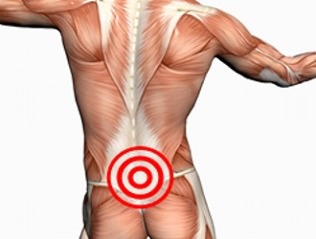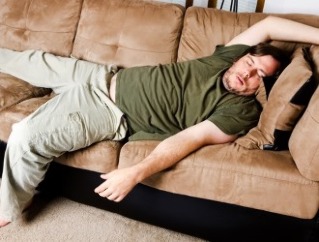
Lumbar osteochondrosisis one of the most common diseases of the spine.
It is characterized by a deformation of the cartilage tissue of the vertebrae.
The spine remains flexible and mobile as long as the vertebrae are healthy.
As the condition worsens, the intervertebral discs lose their elasticity and begin to dry out.
As a result, patients develop severe pain in the lumbar region.
What is it?
When dystrophic-degenerative changes appear in the tissues of the vertebrae, they gradually begin to collapse. If the vertebrae located in the lumbar region are mainly affected, then the diagnosis of osteochondrosis of the lumbar spine is made.
Clinical presentation
In osteochondrosis, the cartilage tissue of the vertebrae begins to lose moisture and the elasticity of the intervertebral discs deteriorates. Over time, the height between the vertebrae decreases. Under the increased load, the annulus fibrosus begins to tear, the intervertebral disc protrudes.This leads to pinching of the nerve endings and the occurrence of pain.
Without adequate treatment, osteochondrosis progresses. The intervertebral discs harden and their damping properties deteriorate. Growths form on the bone tissue of the vertebrae and press on the nerve endings. Because of this, patients develop constant pain.
Degree and classification
Experts differentiate between 4 degrees of osteochondrosis of the spine:
- The process of destruction of the intervertebral discs begins, the symptoms of the disease are mild, a burning sensation, tingling sensation, pain occurs only after physical exertion. Patients talk about the appearance of dull back pain, sometimes it radiates to the buttocks.
- The distance between the vertebrae gradually decreases and the annulus fibrosus begins to collapse. The intervertebral discs are compressed, exceed the physiological limits, there is pressure on the nerve roots. Patients complain of noticeable pain that occurs on the buttocks, thighs and legs when walking. In addition to pain, burning, cold is possible.
- Fibrous rings are destroyed, and intervertebral hernias appear in patients during the examination. The pain is constantly disturbing, regardless of the load.
- Bone outgrowths of the vertebrae are visible. Cartilage atrophy, it becomes difficult for the patient to move. As a result, the lumbar spine loses mobility and flexibility and the patient becomes disabled.
| You also classify osteochondrosis according to the course of the disease: | |
|
|
Experts differentiate between the following periods of osteochondrosis:
- debut;
- aggravation;
- remission;
- stabilization.
Treatment is selected depending on the stage of the disease, the type of deformity and the severity of the disease symptoms.
ICD 10 code
According to the international classification of diseases, the code M42 has been assigned to osteochondrosis of the spine. Juvenile (M42. 0), adult (M42. 1) and unspecified (M42. 9) osteochondrosisare distinguished separately.
Prevalence and importance
The lumbar region is more prone to developing osteochondrosis than other parts of the spine. This is due to the increased stress on this area as it has to support the body weight. With a weak muscle corset, the condition of the intervertebral discs quickly begins to deteriorate, they are destroyed.
Most often people who have passed the 30 year marksuffer from osteochondrosis of the lumbar spine. Although it can be found in younger patients. Osteochondrosis is diagnosed in almost 80% of patients who come to a doctor with complaints of lumbar pain.
The examination of patients over 40 years of age showed that most of them show characteristic changes in the intervertebral discs. However, without clinical manifestations, a person is not considered sick.
Without adequate therapy, the disease progresses. In neglected forms, this leads to the disability of the patient.
Risk factors and causes
Often representatives of such professions encounter osteochondrosis: programmers, office workers, builders, moving companies, waiters, drivers.

The risk factors that increase the likelihood of osteochondrosis include::
- be overweight;
- unhealthy diet;
- problems with posture;
- genetic predisposition;
- lack of sleep;
- frequent stress;
- constant hypothermia;
- must be in an uncomfortable position for a long time;
- little physical activity.
The reasons for the development of osteochondrosis of the lumbar spine are:
- natural aging processes of the body;
- metabolic problems;
- back injuries;
- back problems;
- flat feet;
- intense physical activity, for example weight lifting;
- problems with the joints of the spine (rheumatoid arthritis);
- endocrine diseases;
- Problems with the digestive and cardiovascular systems.
Some experts believe that the tendency to develop osteochondrosis is transmitted at the genetic level.
Consequences
A change in the cartilage tissue between the vertebraeleads to a deterioration of the annulus fibrosus and the appearance of an inguinal hernia. Patients complain of severe pain in the lumbar spine that radiates to the gluteal muscles, thighs, and lower legs. However, this is not the only possible complication of osteochondrosis.
Prolonged irritation of the spinal nerve leads to inflammation.Patients develop a sciatic lumbar spine.
With osteochondrosis,sciatica can develop(inflammation of the sciatic nerve). The disease causes severe pain, numbness in the lower back, legs. Patients begin to walk and lean to one side. This leads to a further curvature of the spine and further destruction of the intervertebral discs.
Osteochondrosis leads to instability of the vertebrae. The lumbar region begins to move from the sacrum under the influence of body weight. In women, such instability leads to the appearance of problems with internal organs (uterus, ovaries, limbs ailments), in men - with potency.
If the intervertebral discs are destroyed, the blood supply to the spinal cord is interrupted, the displacement of the vertebrae leads to compression myelopathy.
The cauda equina syndrome is considered to be the most dangerous complication. It consists in that the nerve roots are affected. In severe cases, osteochondrosis causes paresis of the lower extremities or paralysis of both legs.
You can prevent the development of negative consequences if you consult a doctor when the first symptoms appear and do not ignore the need for treatment.
Symptoms
Osteochondrosis does not appear immediately. In the initial phase, the patient has no pain or discomfort. Symptoms usually arise when the disease reaches stage 2.
The main symptoms of lumbar osteochondrosis are:
- Loin pain that worsens as the disease progresses;
- Impairment of mobility: Problems arise when trying to bend down, turn around. The sensation of changing body position is described by patients as an "electric shock". Pain in many of them radiate to the leg.
- change in the sensitivity of the extremities, which occurred against the background of damage to the nerve roots, in the affected area there is a burning sensation, numbness, creeping creep, tingling sensation;
- Muscle weakness, lack of tendon reflexes;
- local temperature drop;
- increased sweating;
- pale, dry skin in the problem area;
- Urinary disorders, sexual dysfunction (with severe osteochondrosis).
Some patients have spasm of the arteries that run through their legs.. However, the symptoms are expressed only in the acute form of osteochondrosis. An exacerbation can start suddenly with hypothermia, uncomfortable movement, or after intense physical activity.
Which doctor treats?
If you have back pain, you shouldsee an orthopedic surgeon and neurologist. The exam evaluates the patient's neurological condition and checks how the spine is performing its functions. Doctors also assess the condition of your back and buttocks muscles.
For experienced specialists, an examination is sufficient to make a preliminary diagnosis. However, for confirmation, the patient is sent for hardware diagnosis.
Diagnostic methods
The simplest and most accessible method of detecting osteochondrosis isradiography. However, a computer or magnetic resonance imaging is required to obtain a more accurate image.
MRImakes it possible to examine the condition of the spine as precisely as possible. During the procedure, images of the problem area are taken layer by layer.
Treatment

The tactics of therapy are selected by the doctor depending on the patient's condition, the stage of osteochondrosis and the clinical manifestations of the disease.
The doctor canprescribe:
- drug therapy, nonsteroidal anti-inflammatory drugs, hormonal drugs, analgesics are selected;
- Drug blockade, analgesics, and hormonal drugs are injected into the affected area or the muscles around the problem vertebra, relieving inflammation and relieving pain almost immediately.
- Manual therapy, massage, physiotherapyis recommended after you have stopped the acute stage of the disease. With the help of physiotherapy, you can improve the effectiveness of drug treatment.
- Remedial gymnastics;
- acupuncture.
Operation required in advanced cases. Surgical interventions are prescribed in situations when conservative treatment does not bring the expected results.
Conclusion
With the progression ofdystrophic-degenerative changes in the cartilage tissue of the lumbar spine, osteochondrosis is diagnosed. In advanced forms, this disease can lead not only to the appearance of constant severe pain, but also cause paresis, paralysis of the lower extremities.
- You can suspect the development of osteochondrosis from back pain. As the disease progresses, the pain increases significantly and the lower back loses its mobility.
- Depending on the degree of destruction of the intervertebral discsthere are 4 stages of the disease.
- This diagnosis is more common in people after 30 years of age.. Osteochondrosis is diagnosed in almost 80% of patients who see a doctor for back pain.
- People who lead an inactive lifestyle are prone to osteochondrosis, are in an unnatural position for a long time and often suffer from physical overload.
- The main symptoms of osteochondrosis are pain and limited mobility of the lower back.
- Due to the destruction of the intervertebral discs in the lumbar spine, patients develop leg problems.
- If left untreated, the pain increases,sciatica, vertebral instability and compression myelopathycan develop. In advanced cases, it paralyzes the lower limbs.
- In case of paina neurologist and orthopedistmust be consulted. The patient is sent for X-ray, computed tomography, or magnetic resonance imaging.
- Depending on the condition,drugs, blockages, massages, manual therapies, physiotherapy, movement therapies or operations are prescribed..





































